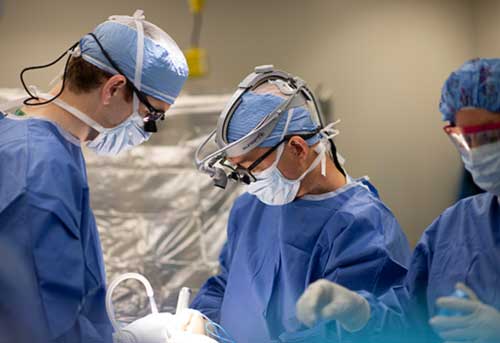Comprehending the Expenses Included with the Best Spine Surgeons in St Louis MO
Comprehending the Expenses Included with the Best Spine Surgeons in St Louis MO
Blog Article
An Overview of Spine Conditions That Commonly Lead To Surgical Treatments
Back problems such as herniated discs, spinal constriction, and degenerative disc illness often require surgical treatments when conservative therapies stop working to reduce persistent symptoms. Understanding the subtleties of each condition and the equivalent surgical options, such as discectomy or back combination, is important for effective monitoring.
Herniated Discs
Although several people with herniated discs may locate relief via traditional therapies, surgical treatment ends up being a necessary consideration when signs and symptoms continue or worsen - best spine surgeons in st louis mo. A herniated disc occurs when the soft internal gel of a spinal disc extends with its outer layer, possibly compressing neighboring nerves and leading to pain, numbness, or weak point in the extremities
Conservative administration normally includes physical therapy, discomfort medications, and corticosteroid injections, which intend to minimize inflammation and improve function. In cases where these techniques fall short to minimize debilitating symptoms, surgical options might be checked out.
The most common operation for herniated discs is a discectomy, which includes the elimination of the herniated section of the disc to alleviate stress on the affected nerve root. In much more serious instances, spine blend might be necessary to support the affected vertebrae.
Individuals are suggested to discuss the potential risks and advantages of surgery with their doctor to make a notified decision. Ultimately, the objective of any type of surgical intervention is to recover function, minimize pain, and enhance overall top quality of life for individuals struggling with herniated discs.
Spine Constriction
Back constriction occurs when the areas within the spine slim, causing boosted pressure on the spine cord and nerves. This problem can establish in various areas of the spine, including the lumbar and cervical areas, often due to age-related adjustments, such as degenerative disc illness, arthritis, or enlarging of ligaments.
People with spine stenosis may offer with symptoms that consist of pain, pins and needles, tingling, or weak point, mostly in the legs or arms. These signs and symptoms can be exacerbated by tasks that include standing or strolling, typically leading individuals to look for relief via traditional treatments like physical treatment, medicines, or epidural steroid shots.
However, when these non-surgical interventions fall short to offer adequate relief, surgical options might be considered. Usual surgeries for back stenosis consist of laminectomy, which involves the elimination of component of the vertebra to relieve pressure, and back combination, which maintains the affected area. The choice to seek surgical treatment is usually based upon the seriousness of signs, the level of useful impairment, and the general health of the person. Trigger medical diagnosis and administration are crucial to stop further neurological concession and improve lifestyle.
Spondylolisthesis
Spondylolisthesis happens when one vertebra slides onward over another, resulting in imbalance of the back. This problem can arise from various elements, including hereditary issues, injury, or degenerative adjustments in the spine. It is most generally observed in the lumbar region, particularly at the L4-L5 and L5-S1 levels.

When non-surgical methods fail to soothe signs or when substantial nerve compression is present, surgical treatment may be called for. Surgical choices can consist of spinal fusion or decompression procedures, aimed at recovering positioning and relieving neurological signs.
Degenerative Disc Condition

Patients with DDD typically experience discomfort that may radiate to the legs or arms, depending upon the impacted area of the spine. The condition can be diagnosed with a combination of medical evaluation, imaging studies, and person history. Treatment alternatives typically begin with conservative steps, including physical treatment, discomfort administration, and way of life adjustments. When these methods fail to provide appropriate alleviation, go to my site medical interventions may be considered.
Surgical alternatives for DDD may consist of spine fusion or man-made disc substitute, targeted at maintaining the impacted sector and easing discomfort (best spine surgeons in st louis mo). Ultimately, the choice of therapy is individualized, thinking about the intensity of the problem, individual health, and way of living factors
Spine Lumps

What aspects add to the growth of tumors within the spinal column, and just how do they show up in patients? Spine lumps can develop from various factors, including genetic tendency, ecological impacts, and pre-existing medical conditions. They can be categorized as primary tumors, coming from in the back, or second lumps, which spread out from various other areas of the body. People might offer with a variety of signs, including localized pain, neurological deficits, weakness, or changes in bowel and bladder feature, depending upon the growth's size and location.
Surgical treatment might be warranted to ease symptoms, acquire a biopsy, or get rid of the growth totally. The goal of surgical procedure is frequently to unwind neural components and stabilize the spine. Early detection and treatment are essential for optimizing end results in patients with spine lumps.
Conclusion
In summary, spinal column conditions such as herniated discs, spinal stenosis, spondylolisthesis, degenerative disc condition, and back tumors frequently necessitate medical treatment due to their prospective to cause substantial pain and practical disability. While traditional therapies may provide blog here temporary relief, surgical choices come to be crucial when signs linger or get worse. Prompt medical diagnosis and treatment play an essential role in restoring function and enhancing the high quality of life for afflicted individuals, highlighting the significance of detailed back treatment.

Report this page